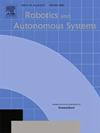End-to-end action model learning from demonstration in collaborative robotics
IF 4.3
2区 计算机科学
Q1 AUTOMATION & CONTROL SYSTEMS
引用次数: 0
Abstract
Access to advanced technology is crucial across all engineering disciplines. In the realm of industrial automation, collaborative robotics serves as a key solution, particularly for small or medium-sized enterprises facing frequent shifts in production demands. This paper introduces a Symbolic Programming by Demonstration approach to efficiently configure and operate a collaborative robotics workstation. While motion profiles (i.e., the how) are taught through the commonly used lead-through programming method, the conditions to check before the execution of a motion and its impact on the environment (the when and what, respectively) are automatically derived using visual feedback. Differently from related works, the present methodology does not require a pre-compiled domain knowledge to encode the semantic characterisation of a demonstrated action (i.e., preconditions and effects). An industrially-relevant use-case, consisting in a collaborative robotics assembly application, is introduced to validate the approach. Results show high success rates in interpreting and solving user-defined tasks (i.e., goals) as well as the capability of the method to generalise well in situations never seen during the acquired demonstrations.
基于协作机器人演示的端到端动作模型学习
获得先进技术对所有工程学科都至关重要。在工业自动化领域,协作机器人是一个关键的解决方案,特别是对于生产需求频繁变化的中小型企业。本文介绍了一种通过演示的符号编程方法来有效地配置和操作协作机器人工作站。虽然运动概况(即,如何)是通过常用的导通编程方法教授的,但在执行运动之前检查的条件及其对环境的影响(分别是何时和什么)是使用视觉反馈自动导出的。与相关工作不同,目前的方法不需要预先编译的领域知识来编码演示动作的语义特征(即先决条件和效果)。介绍了一个与工业相关的用例,由协作机器人装配应用程序组成,以验证该方法。结果表明,在解释和解决用户定义任务(即目标)方面,该方法具有很高的成功率,并且在获得的演示中从未见过的情况下,该方法具有很好的泛化能力。
本文章由计算机程序翻译,如有差异,请以英文原文为准。
求助全文
约1分钟内获得全文
求助全文
来源期刊

Robotics and Autonomous Systems
工程技术-机器人学
CiteScore
9.00
自引率
7.00%
发文量
164
审稿时长
4.5 months
期刊介绍:
Robotics and Autonomous Systems will carry articles describing fundamental developments in the field of robotics, with special emphasis on autonomous systems. An important goal of this journal is to extend the state of the art in both symbolic and sensory based robot control and learning in the context of autonomous systems.
Robotics and Autonomous Systems will carry articles on the theoretical, computational and experimental aspects of autonomous systems, or modules of such systems.
 求助内容:
求助内容: 应助结果提醒方式:
应助结果提醒方式:


